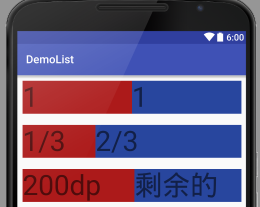weight的意思是权重,在此处可以理解为比例。
<?xml version="1.0" encoding="utf-8"?> <LinearLayout xmlns:android="http://schemas.android.com/apk/res/android" android:layout_width="match_parent" android:layout_height="match_parent" android:orientation="vertical"> <LinearLayout android:layout_margin="10dp" android:layout_width="match_parent" android:layout_height="wrap_content" android:orientation="horizontal"> <TextView android:layout_width="0dp" android:layout_height="wrap_content" android:layout_weight="1" android:background="#ac1a1a" android:text="1" android:textSize="50sp"> </TextView> <TextView android:layout_width="0dp" android:layout_height="wrap_content" android:layout_weight="1" android:background="#28469e" android:text="1" android:textSize="50sp"> </TextView> </LinearLayout> <LinearLayout android:layout_margin="10dp" android:layout_width="match_parent" android:layout_height="wrap_content" android:orientation="horizontal"> <TextView android:layout_width="0dp" android:layout_height="wrap_content" android:layout_weight="1" android:background="#ac1a1a" android:text="1/3" android:textSize="50sp"> </TextView> <TextView android:layout_width="0dp" android:layout_height="wrap_content" android:layout_weight="2" android:background="#28469e" android:text="2/3" android:textSize="50sp"> </TextView> </LinearLayout> <LinearLayout android:layout_margin="10dp" android:layout_width="match_parent" android:layout_height="wrap_content" android:orientation="horizontal"> <TextView android:layout_width="200dp" android:layout_height="wrap_content" android:background="#ac1a1a" android:text="200dp" android:textSize="50sp"> </TextView> <TextView android:layout_width="0dp" android:layout_height="wrap_content" android:layout_weight="1" android:background="#28469e" android:text="剩余的" android:textSize="50sp"> </TextView> </LinearLayout> </LinearLayout>

第一个LinearLayout里的两个textview按1:1分配宽度。
第二个LinearLayout里的两个textview按1:2分配宽度。
第三个LinearLayout里的两个textview一个是固定宽度,另一个占满剩余的宽度。